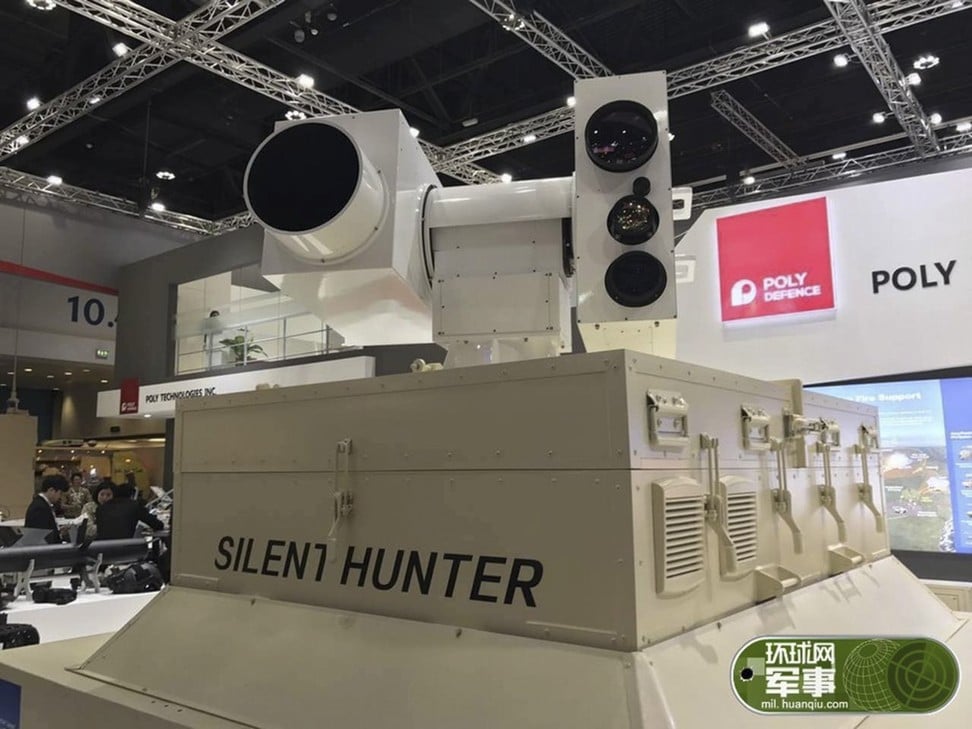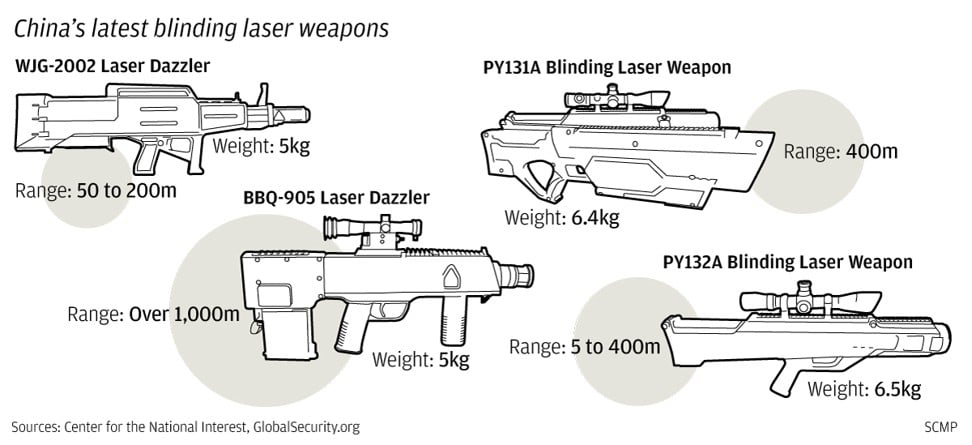
China in race for counter-drone tech and laser weapons as it tries to catch up with US
But with the technology moving at such a rapid pace, ‘these systems are nearly obsolete by the time they are tested’
China is moving to develop laser weapons and counter-drone systems as it tries to catch up with the United States on unmanned aerial vehicle technology to boost its intelligence and attack capabilities, according to military analysts.
That includes systems to protect its drones so that they are less vulnerable to lasers and spoofing techniques that send false information to UAVs. One system under development is Silent Hunter, a portable drone-killing laser weapon that is said to have a firing range of up to 4km and was demonstrated at a defence conference in Abu Dhabi in February.
Poly Technologies, the company behind the Chinese counter-drone system, said it could pierce five layers of 2mm-thick steel plates from a distance of 800m, or 5mm plates from 1km away.

But experts say the US anti-drone systems are more advanced than China’s, and they have a bigger range and more types of sensing technology available from a greater number of companies.
The US has more than 60 counter-drone systems or products that use radar, radio frequency, electro-optical and acoustic detecting and tracking to intercept enemy drones and either stop them, hijack their communication link or destroy them with lasers or projectiles, according to a report by the Centre for the Study of the Drone at Bard College in New York in February.
Its latest acquisition is a high-power microwave counter-drone system, which the US Army earlier this month said it planned to buy from Lockheed Martin, according to the company’s website. The system is a laser weapon that is carried by an aircraft and can shoot airborne drones, and has more attack power than ground-based or handheld weapons.
Chinese underwater drone maker’s plan to rule the waves could be scuppered by US trade war
China, meanwhile, has less than 20 such systems and mainly relies on conventional means like radar to detect drones – and it does not have any spoofing or nets to counter incoming UAVs, according to the report and mainland media. Jamming systems appear to be the most popular way to counter drones in China.
But analysts say China is starting to catch up, with a number of companies and institutions joining the race to research counter-drone technology, including China National Nuclear Corporation, NovaSky and the Beijing Institute of Technology.
New systems might not be publicly announced or demonstrated though, according to Kelvin Wong, an aerospace analyst with IHS Markit.
“I believe that there are many more state-owned and private Chinese firms as well as research institutions that have enter the counter-UAS [unmanned aircraft system]/UAV market,” Wong said.
Seven Chinese defence firms in world’s top 20, international think tank says
Arthur Holland Michel, from the Centre for the Study of the Drone, said those in the race all had a chance of coming up with the next big thing in counter-drone systems.
“Given that we are talking about an emerging technology, it is plausible that a small start-up might come up with a brilliant solution that completely dominates the market – the way that DJI, a Chinese start-up, has become a market leader in the consumer drone sector,” he said.
DJI unveils latest Mavic drones that allow users to zoom while they fly
Based in Shenzhen, DJI makes commercial drones used for aerial photography and videography and has an estimated 70 per cent share of the global market. It also designs and manufactures flight platforms and control systems.

Brett Velicovich, a US army veteran and drone expert, said the industry was making such rapid advances that no single weapon would be 100 per cent effective against every type of drone in every situation – the technology simply could not keep up, and that was a challenge everywhere.
“The problem largely comes from the fact that the current state of drone technology is moving at such a rapid pace, that these counter-drone systems are nearly obsolete by the time they are tested, ” he said.
Velicovich added that the best approach was a multipronged strategy combining different interception techniques. He said acoustic detection – where a drone is picked up by its unique sound, triggering a system to eliminate the threat – was one area where more research was needed.
WAYS TO INTERCEPT A DRONE
1. Radio frequency jamming
Disrupts the radio frequency link between the drone and its operator by generating large volumes of RF output. Once the RF l
ink is severed, a drone will either descend to the ground or return home.
2. GNSS jamming
Disrupts the drone’s satellite link, such as to a GPS (global positioning system) or GLONASS (global navigation satellite system). Once the navigation direction is lost, a drone will hover, land or return home.
3. Spoofing
The drone’s communications link is hijacked to take control of it.
4. Laser
Destroys vital parts of the drone, causing it to crash to the ground.
5. Nets
Entangles the targeted drone and/or its rotors.
6. Projectile
Ammunition – regular or custom-designed – is used to break or destroy an incoming unmanned aircraft.
7. Combined interdiction elements
Uses several C-UAS (counter-unmanned aircraft systems) together – most commonly, RF and GNSS jamming systems that work in tandem.


